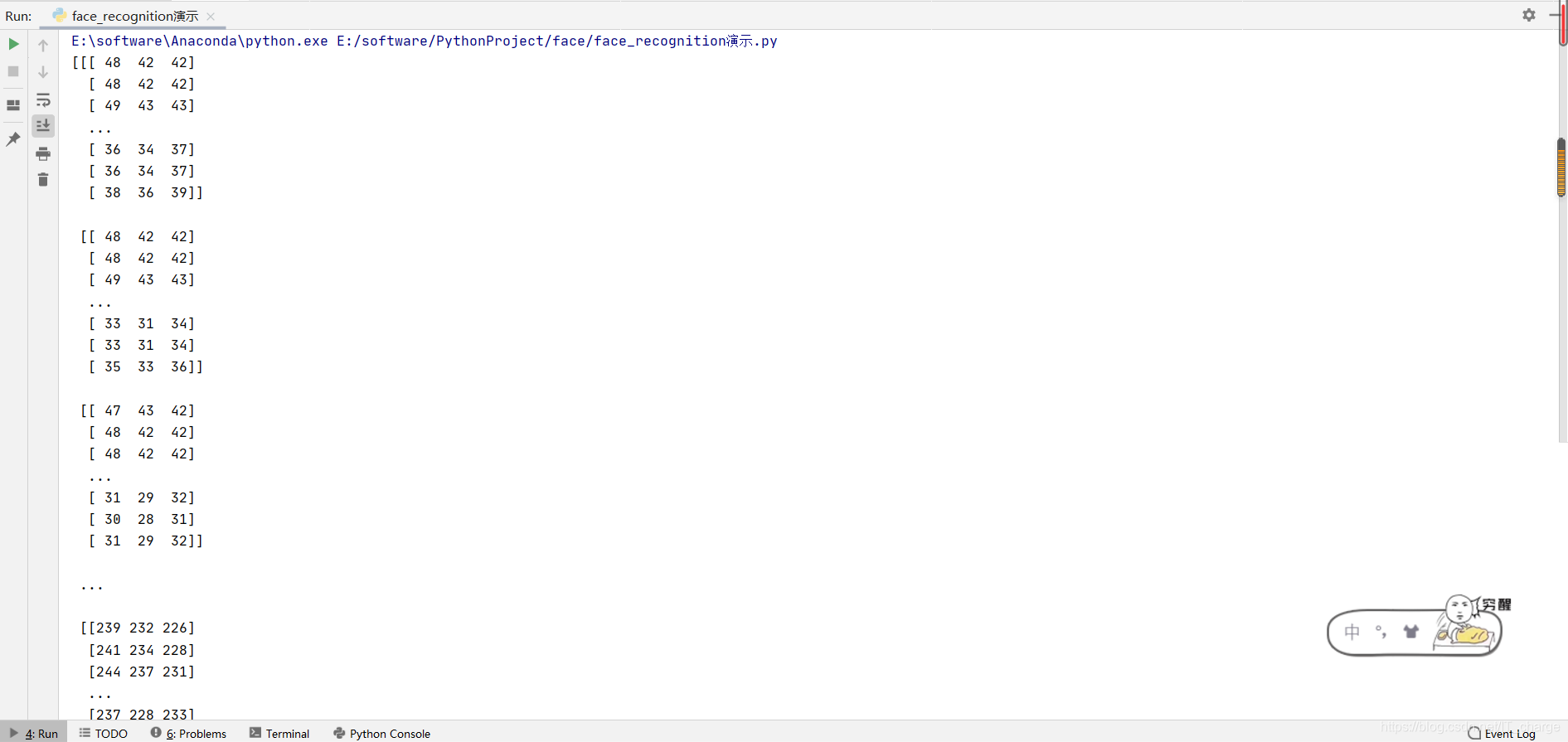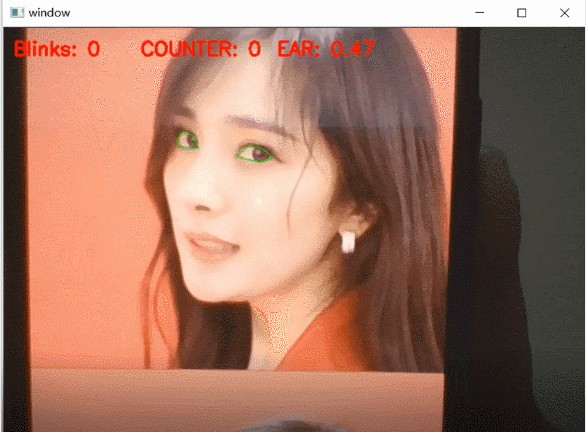前段时间来到中关村重庆基地实训,老师要求每人提交一张本人白底免冠照片用于录入门禁监控系统,我当时想:好高级哇,一张照片就可以耶;神经网络训练模型还得好多张图片不断轮次迭代才能产生好的效果呢。当时的我非常好奇,心生崇拜之意,一直梦想着自己也能开发出这样一个系统,然而,不久之后的现在,成功了!回头再看门口那个门禁监控系统:呵~不过如此!
目录
2.2 face_recognition 库的安装与实例解析
1 人脸识别应用所涉及到的功能模块
- 摄像头调用
- 脸部图像识别和处理
- 活体检测
- 多线程的应用
- 定时器的调用
2 人脸识别的基本过程
- 人脸的 68 个基本特征点位置以及顺序。判断 68 个特征点在图像上面是否存在、是否完整;
- 人脸 detect,这一步主要就是定位人脸在图像中的位置,利用目标检测算法输出人脸位置矩形框;
- 人脸 shape?predictor,这一步就是要找出眼睛眉毛鼻子嘴巴具体的点位;
- 人脸对齐 alignment,这一步主要是通过投影几何变换出一张标准脸;
- 人脸识别,这一步就是在对挤的人脸图像上提取 128 维的特征向量,根据特征向量间的距离来进行判断识别。
python 中最常用的人脸识别库是基于 C++ 开发的 dlib 库。
2.1 dlib 库的安装与实例解析
dlib 库需要单独安装,dlib 库目前已经编译好的安装版本只支持 python 3.6 的版本。
这里再提供一个 python 3.7 版本的 dlib 库 whl 文件:链接:https://pan.baidu.com/s/1Fch0AqhZTmql7MpFyEDtYA? ?提取码:re7z
# -*-coding:GBK -*-
import dlib
from skimage import io
detector = dlib.get_frontal_face_detector() # 获取一个脸部检测器,这个监测器包含了脸部检测算法
win = dlib.image_window()
img = io.imread('E:/girl.png') # 读取带辨别的图像
# 利用脸部检测器读取待检测的图像数据,第二个参数1代表读取图片像素并放大1倍以便能够收集到更多的照片细节
# 返回结果是一组人脸区域的数据
ders = detector(img, 1)
win.set_image(img)
win.add_overlay(ders)
dlib.hit_enter_to_continue()
2.2 face_recognition 库的安装与实例解析
face_recognition 库是基于 dlib 进行了二次封装,号称世界上最简洁的人脸识别库。
训练数据集:Labeled?Faces?in?the?Wild,13000 多人脸作为训练数据集,识别效果取决于样本的数量以及质量。
windows 上安装:?pip?install?-i?https://pypi.douban.com/simple?face_recognition
2.2.1?load_image_file
load_image_file 这个方法主要用于加载要识別的人脸图像,加载返回的数据是 Numpy 数組,记录了图片的所有像素的特征向量。
# -*-coding:GBK -*-
import face_recognition
image = face_recognition.load_image_file('E:/girl.jpg')
print(image)
2.2.2?face_locations?
face_locations?定位图中所有的人脸的像素位置。
- 返回值是一个列表形式,列表中每一行是一张人脸的位置信息,包括[top,?right,?bottom, left],也可以认为每个人脸就是一组元组信息。主要用于标识图像中所有的人脸信息。
# -*-coding:GBK -*-
import face_recognition
from PIL import Image
import cv2
# 通过 load_image_file 方法加载待识别图片
image = face_recognition.load_image_file('E:/girls.jpg')
# 通过 face_locations 得到图像中所有人脸位置
face_locations = face_recognition.face_locations(image)
for face_location in face_locations:
top, right, bottom, left = face_location # 结报操作,得到每张人脸的四个位置信息
print("已识别到人脸部位,限速区域为:top{}, right{}, bottom{}, left{}".format(top, right, bottom, left))
# face_image = image[top:bottom, left:right]
# pil_image = Image.fromarray(face_image)
# pil_image.show()
start = (left, top)
end = (right, bottom)
# 在图片上绘制矩形框
cv2.rectangle(image, start, end, (0,0,255), thickness=2)
cv2.imshow('window', image)
cv2.waitKey()

2.2.3?face_landmarks
face_landmarks 识别人脸关键特征点。
- 参数仍然是待检测的图像对象,返回值是包含面部特征点字典的列表,列表长度就是图像中的人脸数。
- 面部特征包括以下几个部分:nose_bridge?(鼻梁)、right?_eyebrow?(右眼眉)、left_eyebrow?(左眼眉)、right_eye(右眼)、left_eye(左眼)、chin(下巴)、?nose_tip(下鼻部)、bottom_lip?(下嘴唇)?
- 勾勒脸部大体轮廓
# -*-coding:GBK -*-
import face_recognition
from PIL import Image, ImageDraw
image = face_recognition.load_image_file('E:/boys.jpg')
face_landmarks_list = face_recognition.face_landmarks(image)
pil_image = Image.fromarray(image)
d = ImageDraw.Draw(pil_image) # 生成一张PIL图像
for face_landmarks in face_landmarks_list:
facial_features = [
'chin',
'left_eyebrow',
'right_eyebrow',
'nose_bridge',
'nose_tip',
'left_eye',
'right_eye',
'bottom_lip'
]
for facial_feature in facial_features:
# print("每个人的面部特征显示在以下为位置:{}".format(facial_feature))
d.line(face_landmarks[facial_feature], width=5) # 直接调用PIL中的line方法在PIL图像中绘制线条,帮助我们观察特征点
pil_image.show()
2.2.4?face_encodings
face_encodings 获取图像文件中所有面部编码信息。
- 返回值是一个编码列表,参数仍然是要识别的图像对象。如果后续访问时,需要注意加上索引或遍历来进行访问。每张人脸的编码信息是一个 128 维向量。
- 面部编码信息是进行人像对比的重要参数。
# -*-coding:GBK -*-
import face_recognition
image = face_recognition.load_image_file('E:/boys.jpg')
# 不管图像中有多少个人脸信息,返回值都是一个列表
face_encodings = face_recognition.face_encodings(image)
for face_encoding in face_encodings:
print("信息编码长度为:{}\n编码信息为:{}".format(len(face_encoding), face_encoding))
2.2.5?compare_faces?
compare_faces?由面部编码信息进行面部识别匹配。
- 主要用于匹配两个面部特征编码,利用这两个特征向量的内积来衡量相似度,根据阈值确认是否是同一个人。
- 第一个参数就是一个面部编码列表(很多张脸),?第二个参数就是给出单个面部编码(一张脸),?compare_faces 会将第二个参数中的编码信息与第一个参数中的所有编码信息依次匹配,返回值是一个布尔列表,匹配成功则返回 True,匹配失败则返回 False,顺序与第一个参数中脸部编码顺序一致。
- 参数里有一个 tolerance = 0.6,大家可以根据实际的效果进行调整,一般经验值是 0.39。
tolerance 值越小,匹配越严格。
# -*-coding:GBK -*-
import face_recognition
# 加载一张合照
image1 = face_recognition.load_image_file('./facelib/yangmi+liukaiwei.jpeg')
# 加载一张单人照
image2 = face_recognition.load_image_file('./facelib/yangmi.jpg')
known_face_encodings = face_recognition.face_encodings(image1)
# face_encodings返回的是列表类型,我们只需要拿到第一个人脸编码即可
compare_face_encodings = face_recognition.face_encodings(image2)[0]
# 注意第二个参数,只能是答案个面部特征编码,不能传列表
matches = face_recognition.compare_faces(known_face_encodings, compare_face_encodings)
print(matches)
2.2.6 获取摄像头的图像信息?
我们可以利用 cv2 模块中的 VideoCapture 方法,然后每次读取其中的一帧图像进行处理即可。
# -*-coding:GBK -*-
import cv2
from PIL import Image, ImageDraw
import numpy as np
# 1.调用摄像头
# 2.读取摄像头图像信息
# 3.在图像上添加文字信息
# 4.保存图像
cap = cv2.VideoCapture(0) # 调用第一个摄像头信息
while True:
ret, frame = cap.read()
# BGR是cv2 的图像保存格式,RGB是PIL的图像保存格式,在转换时需要做格式上的转换
img_PIL = Image.fromarray(cv2.cvtColor(frame, cv2.COLOR_BGR2RGB))
draw = ImageDraw.Draw(img_PIL)
draw.text((100, 100), 'press q to exit', fill=(255, 255, 255))
# 将frame对象转换成cv2的格式
frame = cv2.cvtColor(np.array(img_PIL), cv2.COLOR_RGB2BGR)
cv2.imshow('capture', frame)
if cv2.waitKey(1) & 0xFF == ord('q'):
cv2.imwrite('out.jpg', frame)
break
cap.release()
3 实现人脸识别的监控系统
整理人脸识别监控系统主要功能:
- 打开摄像头读取图像 ok
- 与已知人物头像进行对比,识别哪些是已知人员,哪些是未知人员 ok
- 在摄像头图像上直接标注对比结果 ok
- 记录每次对比的结果,并将未知人员的图像进行保存
- 活体检测
3.1 人脸识别监控系统
# -*-coding:GBK -*-
import face_recognition
import os
import cv2
from PIL import Image, ImageFont, ImageDraw
import numpy as np
import datetime
import threading
class Recorder:
pass
record_dic = {}
unknown_pic = []
flag_over = 0 # 定义一个是否进行来访记录的标记
# 定时去保存对比图像信息,并且将位置人员的图像保存下来
def save_recorder(name, frame):
global record_dic
global flag_over
global unknown_pic
if flag_over == 1: return
try:
record = record_dic[name]
seconds_diff = (datetime.datetime.now() - record.times[-1]).total_seconds()
if seconds_diff < 60 * 10:
return
record.times.append(datetime.datetime.now())
print('更新记录', record_dic, record.times)
except KeyError:
newRec = Recorder()
newRec.times = [datetime.datetime.now()]
record_dic[name] = newRec
print('添加记录', record_dic, newRec.times)
if name == '未知头像':
s = str(record_dic[name].times[-1])
# print(s)
# 未知人员的图片名称
filename = s[:10]+s[-6:] + '.jpg'
cv2.imwrite(filename, frame)
unknown_pic.append(filename)
# 解析已有人员的所有照片并得到照片名和人物面部编码信息
def load_img(path):
print('正在加载已知人员的图片...')
for dirpath, dirnames, filenames in os.walk(path):
print(filenames)
facelib = []
for filename in filenames:
filepath = os.sep.join([dirpath, filename])
# 把对应每张图片加载进来
face_image = face_recognition.load_image_file(filepath)
face_encoding = face_recognition.face_encodings(face_image)[0]
facelib.append(face_encoding)
return facelib,filenames
facelib, facenames = load_img('facelib')
# print(facenames)
video_capture = cv2.VideoCapture(0)
while True:
ret, frame = video_capture.read()
# 通过缩小图片(缩小为1/4),提高对比效率
small_frame = cv2.resize(frame, (0,0), fx=0.25, fy=0.25)
rgb_small_frame = small_frame[:,:,::-1] # 将opencv的BGR格式转换为RGB格式
face_locations = face_recognition.face_locations(rgb_small_frame)
face_encodings = face_recognition.face_encodings(rgb_small_frame, face_locations)
face_names = []
# 循环多张人脸
for face_encoding in face_encodings:
matches = face_recognition.compare_faces(facelib, face_encoding, tolerance=0.39)
name = '未知头像'
if True in matches:
# 如果摄像头里面的头像匹配了已知人物头像,则取出第一个True的位置
first_match_index = matches.index(True)
name = facenames[first_match_index][:-4] # 取出文件上对应的人名
face_names.append(name)
for (top, right, bottom, left), name in zip(face_locations, face_names):
# 还原原图片大小
top *= 4
right *= 4
bottom *= 4
left *= 4
cv2.rectangle(frame, (left, top), (right, bottom), (0,0,255), thickness=2) # 标注人脸信息
img_PIL = Image.fromarray(cv2.cvtColor(frame, cv2.COLOR_BGR2RGB))
font = ImageFont.truetype('simhei.ttf', 40)
draw = ImageDraw.Draw(img_PIL)
draw.text((left+6, bottom-6), name, font=font, fill=(255,255,255))
frame = cv2.cvtColor(np.asarray(img_PIL),cv2.COLOR_RGB2BGR)
save_recorder(name, frame)
cv2.imshow('capture', frame)
if cv2.waitKey(1) & 0xFF == ord('q'):
break
video_capture.release()

3.2 眨眼活体检测
# -*-coding:GBK -*-
from scipy.spatial import distance
import dlib
import cv2
from imutils import face_utils
def eye_aspect_ratio(eye):
'''
计算EAR值
:param eye: 眼部特征点数组
:return: EAR值
'''
A = distance.euclidean(eye[1], eye[5])
B = distance.euclidean(eye[2], eye[4])
C = distance.euclidean(eye[0], eye[3])
return (A+B) / (2.0*C)
detector = dlib.get_frontal_face_detector()
predictor = dlib.shape_predictor('shape_predictor_68_face_landmarks.dat')
# 设置眼睛纵横比的阈值
EAR_THRESH = 0.3
# 我们假定连续3帧以上的EAR的值都小于阈值,才确认是产生了眨眼操作
EAR_CONSEC_FRAMES = 3
# 人脸特征点中对应眼睛的那几个特征点的序号
RIGHT_EYE_START = 37-1
RIGHT_EYE_END = 42-1
LEFT_EYE_START = 43-1
LEFT_EYE_END = 48-1
frame_counter = 0 # 连续帧的计数
blink_counter = 0 # 眨眼的计数
cap = cv2.VideoCapture(0)
while True:
ret, frame = cap.read()
gray = cv2.cvtColor(frame, cv2.COLOR_BGR2GRAY) # 转化为灰度图像
rects = detector(gray, 1) # 人脸检测
if len(rects) > 0:
shape = predictor(gray, rects[0]) # 检测特征点
points = face_utils.shape_to_np(shape)
leftEye = points[LEFT_EYE_START:LEFT_EYE_END + 1] # 取出左眼特征点
rightEye = points[RIGHT_EYE_START:RIGHT_EYE_END + 1] # 取出右眼特征点
# 计算左右眼的EAR值
leftEAR = eye_aspect_ratio(leftEye)
rightEAR = eye_aspect_ratio(rightEye)
# 求左右眼EAR的平均值
ear = (leftEAR+rightEAR) / 2.0
# 实际判断一下眼轮廓部分代码并不是必须的
# 寻找左右眼的轮廓
leftEyeHull = cv2.convexHull(leftEye)
rightEyeHull = cv2.convexHull(rightEye)
# 绘制左右眼轮廓
cv2.drawContours(frame, [leftEyeHull], -1, (0,255,0), 1)
cv2.drawContours(frame, [rightEyeHull], -1, (0, 255, 0), 1)
# 如果EAR小于阈值,开始计算连续帧
if ear < EAR_THRESH:
frame_counter += 1
else:
if frame_counter >= EAR_CONSEC_FRAMES:
print('眨眼检测成功,请进入')
frame_counter += 1
break
frame_counter = 0
cv2.putText(frame, "COUNTER: {}".format(frame_counter), (150, 30),
cv2.FONT_HERSHEY_SIMPLEX, 0.7, (0, 0, 255), 2)
cv2.putText(frame, "Blinks: {}".format(blink_counter), (10, 30),
cv2.FONT_HERSHEY_SIMPLEX, 0.7, (0, 0, 255), 2)
cv2.putText(frame, "EAR: {:.2f}".format(ear), (300, 30),
cv2.FONT_HERSHEY_SIMPLEX, 0.7, (0, 0, 255), 2)
# cv2.putText(frame, 'blink:{}'.format(blink_counter))
cv2.imshow('window', frame)
if cv2.waitKey(1) & 0xFF == ord('q'):
cv2.imwrite('out.jpg', frame)
break
cap.release()
cv2.destroyAllWindows()
